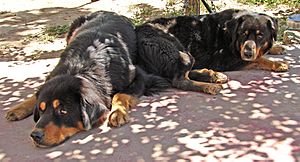Tibetan Mastiff facts for kids
The Tibetan Mastiff is a very large and strong dog breed. It comes from the high mountains of Tibet in Central Asia. These dogs have a thick, long coat, often black, brown, or gold. They look a bit like a lion because of the thick fur around their neck, which is called a mane.
Contents
History of the Tibetan Mastiff
Tibetan Mastiffs have been around for thousands of years. They were first used by nomadic people in the Himalayas to protect their homes, livestock, and villages from predators like wolves and snow leopards. They are known for being very brave and watchful guard dogs. These dogs were also used to guard monasteries and camps.
What They Look Like
Tibetan Mastiffs are one of the largest dog breeds in the world.
- Size: Male Tibetan Mastiffs can stand over 26 inches (66 cm) tall and weigh over 100 pounds (45 kg). Females are a bit smaller.
- Coat: They have a double coat, which means they have a soft, woolly undercoat and a long, thick outer coat. This helps them stay warm in cold mountain climates. Their fur can be black, brown, blue-grey, or gold, sometimes with tan markings.
- Mane: Many Tibetan Mastiffs have a thick mane of fur around their neck and shoulders, making them look like a lion.
Personality and Temperament
Tibetan Mastiffs are known for being very loyal and protective of their families.
- Guard Dogs: They are natural guard dogs and can be very protective of their territory.
- Independent: These dogs can be quite independent and think for themselves. This means they need consistent training from a young age.
- Calm Indoors: While they are powerful outdoors, they can be calm and quiet inside the house, especially if they get enough exercise.
- Good with Family: They are usually good with children and other pets in their own family, but they need to be socialized early to get along with strangers.
Caring for a Tibetan Mastiff
Caring for a Tibetan Mastiff requires a lot of commitment.
- Training: Early and consistent training is very important because they are intelligent and can be stubborn. Positive reinforcement methods work best.
- Exercise: They need regular exercise, like daily walks or playtime in a secure yard.
- Grooming: Their thick coat needs regular brushing, especially during shedding season, to prevent mats and keep it healthy.
- Space: Because of their size, they do best in homes with a large, secure yard.
Did You Know?
- Tibetan Mastiffs are sometimes called "Do Khyi," which means "door guard" in Tibetan.
- They are known for their deep, booming bark, which they use to warn off intruders.
- In some cultures, owning a Tibetan Mastiff is a sign of wealth and status.
Images for kids
-
Artwork depicting a Tibetan Mastiff from the Qing dynasty.
See also
 In Spanish: Dogo del Tíbet para niños
In Spanish: Dogo del Tíbet para niños











